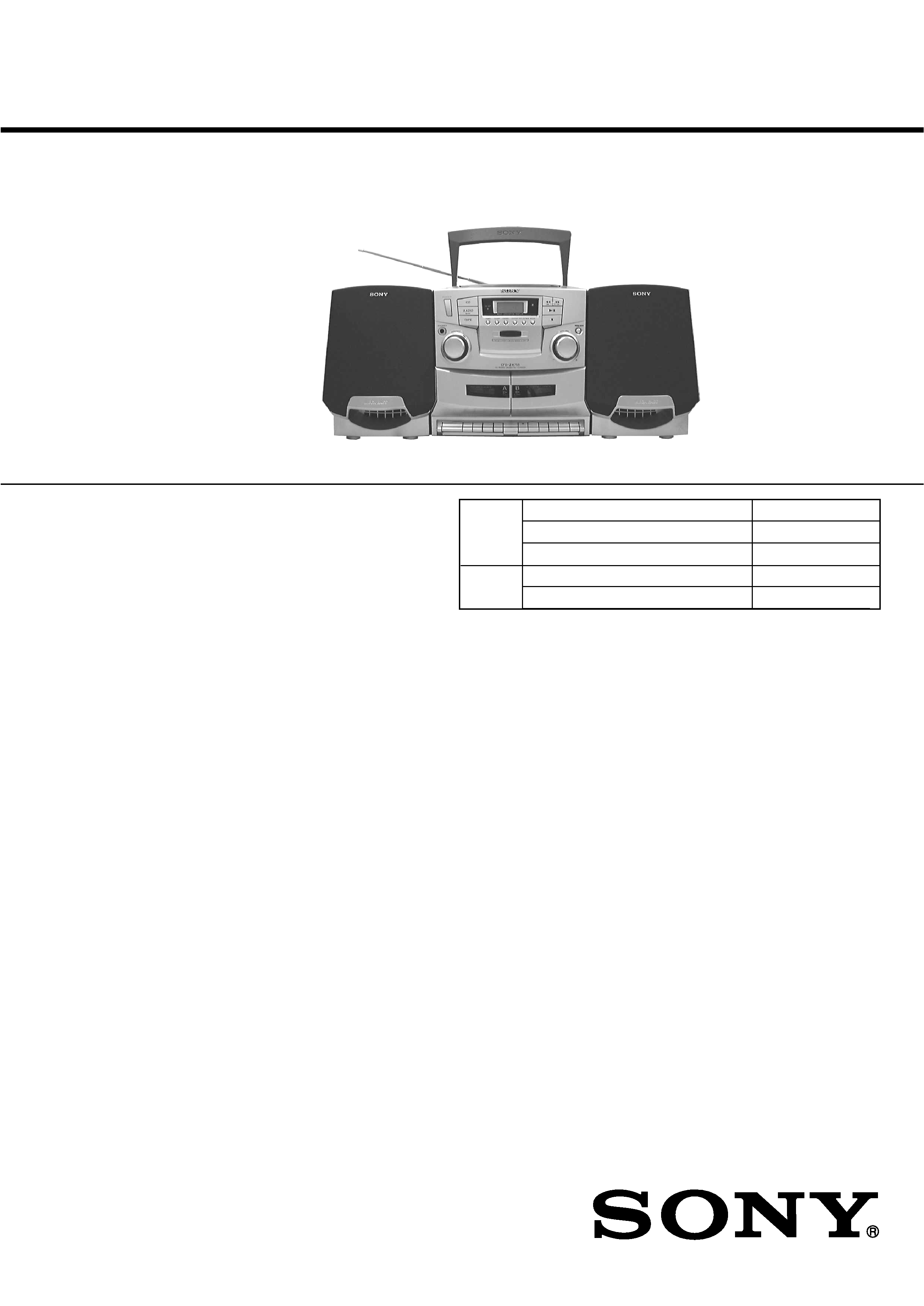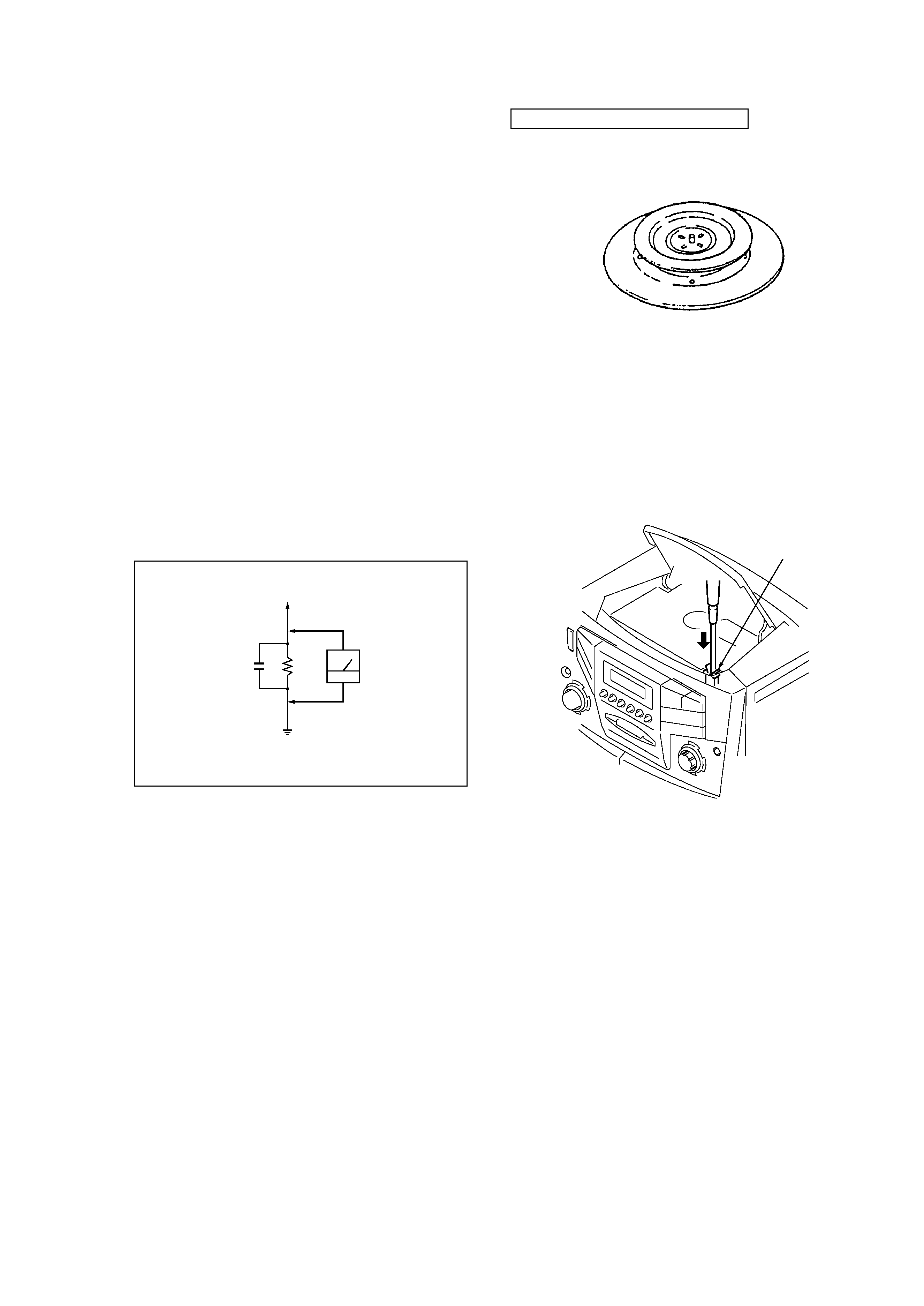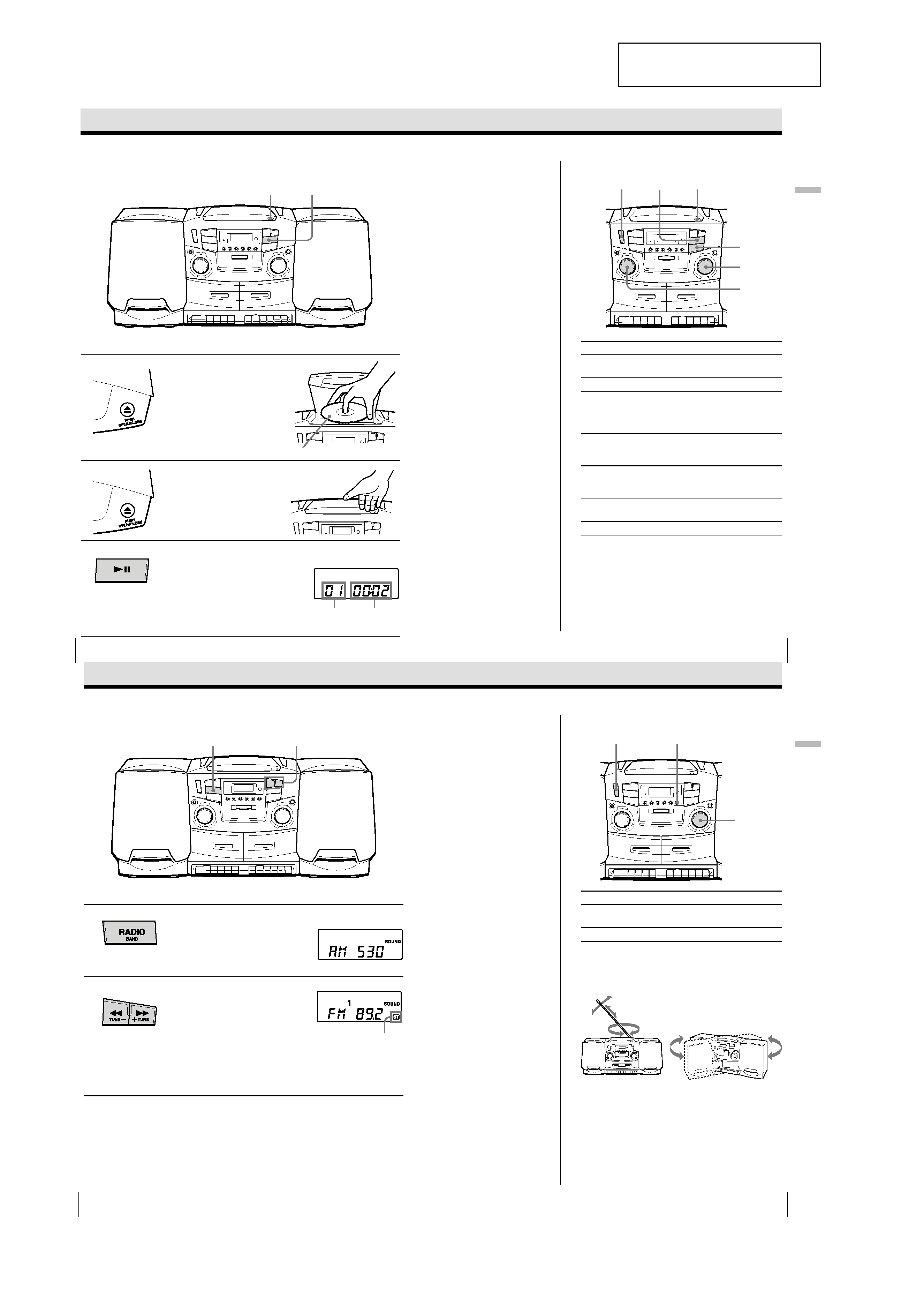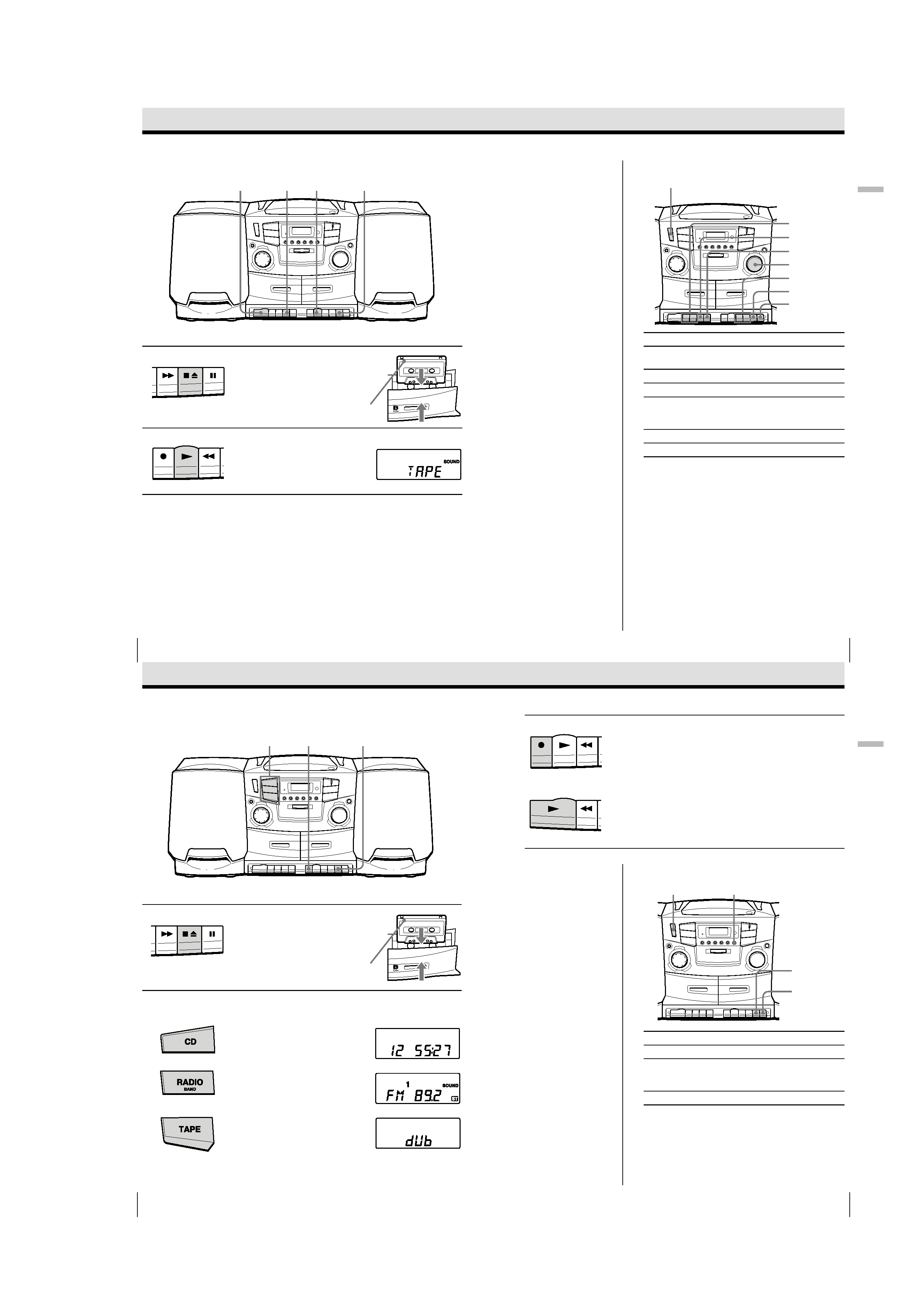
CFD-ZW755
SERVICE MANUAL
CD RADIO CASSETTE-CORDER
SPECIFICATIONS
US Model
CD
Model Name Using Similar Mechanism
CFD-ZW750/ZW770
CD Machanism Type
KSM-213CDM
Section
Optical Pick-up Type
KSS-213C
TC
Model Name Using Similar Machanism
NEW
Section
Tape Transport Mechanism Type
MF-ZW755-117
AUDIO POWER SPECIFICATIONS
POWER OUTPUT AND TOTAL HARMONIC DISTORTION
With 3.2-ohm loads, both channel driven from 150 - 6,300 Hz; rated 1.6
W per channel-minimum RMS power, with no more than
10 % total harmonic distortion in AC operation.
Other Specifications
CD player section
System
Compact disc digital audio system
Laser diode properties
Material: GaAlAs
Wave length: 780 nm
Emission duration: Continuous
Laser output: Less than 44.6
µW
(This output is the value measured at a distance of about 200
mm from the objective lens surface on the optical pick-up
block with 7 mm aperture.)
Spindle speed
200 r/min (rpm) to 500 r/min (rpm) (CLV)
Number of channels
2
Frequency response
20 - 20,000 Hz +1/1 dB
Wow and flutter
Below measurable limit
Radio section
Frequency range
FM: 87.5 - 108 MHz
AM:530 - 1,710 kHz
Antennas
FM: Telescopic antenna
AM: Built-in ferrite bar antenna
Cassette-corder section
Recording system
4-track 2 channel stereo
Fast winding time
Approx. 120 s (sec.) with Sony cassette C-60
Frequency response
TYPE I (normal): 80 - 10,000 Hz
General
Speaker
Full range: 10 cm (4 in.) dia.,
3.2 ohms, cone type (2)
Outputs
Headphones jack (stereo minijack)
For 16 - 68 ohms impedance headphones
Power requirements
For CD radio cassette-corder:
120 V AC, 60 Hz
9 V DC, 6 size D (R20) batteries
For memory back-up:
4.5 V DC, 3 size AA (R6) batteries
For remote control:
3 V DC, 2 size AA (R6) batteries
Continued on page 2
9-927-694-14
2005I02-1
© 2005.09
Sony Corporation
Personal Audio Group
Published by Sony Engineering Corporation
Ver. 1.3 2005.09
With SUPPLEMENT-1

2
SAFETY-RELATED COMPONENT WARNING!!
COMPONENTS IDENTIFIED BY MARK
! OR DOTTED LINE WITH
MARK
! ON THE SCHEMATIC DIAGRAMS AND IN THE PARTS
LIST ARE CRITICAL TO SAFE OPERATION.
REPLACE THESE COMPONENTS WITH SONY PARTS WHOSE
PART NUMBERS APPEAR AS SHOWN IN THIS MANUAL OR IN
SUPPLEMENTS PUBLISHED BY SONY.
TABLE OF CONTENTS
Specifications ........................................................................... 1
1. SERVICING NOTES .................................................... 3
2. GENERAL ....................................................................... 4
3. DISASSEMBLY
3-1. Cabinet (Rear) .......................................................... 6
3-2. Power Board, Back up Board, Battery Board ........... 6
3-3. CD Block ASSY ....................................................... 7
3-4. Control Board ........................................................... 7
3-5. Power Key Board, Mega Bass Board,
Preset Board, Volume Board ..................................... 8
3-6. Key Board ................................................................. 8
3-7. Headphone Board ..................................................... 8
3-8. REC SW Board, PB Board ....................................... 9
3-9. Mechanism Deck ...................................................... 9
3-10. Capstan/reel Motor (M301), Belt ........................... 10
3-11. Main Board ............................................................. 10
3-12. CD Board ................................................................. 11
3-13. Optical pick-up Block ............................................. 11
4. ADJUSTMENTS
4-1. Mechanical Adjustments ........................................... 12
4-2. Electrical Adjustments .............................................. 12
5. DIAGRAMS
5-1. Explanation of IC Terminals ..................................... 15
5-2. Block Diagrams ........................................................ 17
5-3. Schematic Diagram (Main Section) ......................... 21
5-4. Printed Wiring Boards (Main Section) ..................... 25
5-5. Printed Wiring Boards (Control Section) ................. 28
5-6. Schematic Diagram (Control Section) ...................... 31
5-7. Printed Wiring Boards (CD Section) ........................ 34
5-8. Schematic Diagram (CD Section) ............................ 37
6. EXPLODED VIEWS
6-1. Rear Cabinet Section ............................................... 44
6-2. Front Cabinet Section .............................................. 45
6-3. CD Section .............................................................. 46
6-4. Tape Mechanism Section-1 (MF-ZW755-117) ....... 47
6-5. Tape Mechanism Section-2 (DECK A)
(MF-ZW755-117) ................................................... 48
6-6. Tape Mechanism Section-3 (DECK A)
(MF-ZW755-117) ................................................... 49
6-7. Tape Mechanism Section-4 (DECK B)
(MF-ZW755-117) ................................................... 50
6-8. Tape Mechanism Section-5 (DECK B)
(MF-ZW755-117) ................................................... 51
6-9. Optical pick-up Section (KSM-213CDM) .............. 52
6-10. Speaker Section ....................................................... 53
7. ELECTRICAL PARTS LIST .................................... 54
CAUTION
Use of controls or adjustments or performance
of procedures other than those specified herein
may result in hazardous radiation exposure.
Power consumption
AC 15 W
Battery life
For CD radio cassette-corder:
FM recording
Sony R20P:
approx. 7.5 h
Sony alkaline LR20:
approx. 22 h
Tape playback
Sony R20P:
approx. 7 h
Sony alkaline LR20:
approx. 20 h
CD playback
Sony R20P:
approx. 3 h
Sony alkaline LR20:
approx. 10 h
For memory back-up: approx. 1 year
Dimensions
Approx. 650 x 265 x 256 mm (w/h/d)
(25 5/8 x 10 1/2 x 10 1/8 inches) (incl. projecting parts)
Mass
Approx. 6.7 kg (14 lb. 12 oz) (incl. batteries)
Supplied accessory
AC power cord (1)
Remote control (1)
Design and specifications are subject to change without notice.
NOTES ON HANDLING THE OPTICAL PICK-UP
BLOCK OR BASE UNIT
The laser diode in the optical pick-up block may suffer electro-
static breakdown because of the potential difference generated
by the charged electrostatic load, etc. on clothing and the human
body.
During repair, pay attention to electrostatic breakdown and also
use the procedure in the printed matter which is included in the
repair parts.
The flexible board is easily damaged and should be handled
with care.
NOTES ON LASER DIODE EMISSION CHECK
The laser beam on this model is concentrated so as to be focused
on the disc reflective surface by the objective lens in the optical
pick-up block. Therefore, when checking the laser diode
emission, observe more than 30 cm away from the objective
lens.
Flexible Circuit Board Repairing
· Keep the temperature of the soldering iron around 270
°C during
repairing.
· Do not touch the soldering iron on the same conductor of the
circuit board (within 3 times).
· Be careful not to apply force on the conductor when soldering or
unsoldering.
Notes on chip component replacement
· Never reuse a disconnected chip component.
· Notice that the minus side of a tantalum capacitor may be dam-
aged by heat.

3
CHUCK PLATE JIG ON REPAIRING
On repairing CD section, playing a disc without the CD lid, use
Chuck Plate Jig.
· Code number of Chuck Plate Jig : X-4918-255-1
SECTION 1
SERVICING NOTES
LASER DIODE AND FOCUS SEARCH OPERATION
CHECK
1. Turn on POWER button and press CD button to CD
position.
2. Open the CD lid.
3. Turn on S901 as following figure.
4. Confirm the laser diode emission while observing the
objecting lens. When there is no emission, Auto Power
Control circuit or Optical Pick-up is broken.
Objective lens moves up and down three for focus search.
SAFETY CHECK-OUT
After correcting the original service problem, perform the
following safety check before releasing the set to the customer :
Check the antenna terminals, metal trim, "metallized" knobs,
screws, and all other exposed metal parts for AC leakage. Check
leakage as described below.
LEAKAGE TEST
The AC leakage from any exposed metal part to earth ground and
from all exposed metal parts to any exposed metal part having a
return to chassis, must not exceed 0.5mA (500 microampers).
Leakage current can be measured by any one of three methods.
1. A commercial leakage tester, such as the Simpson 229 or RCA
WT-540A. Follow the manufacturers' instructions to use these
instruments.
2. A battery-operated AC milliammeter. The Data Precision 245
digital multimeter is suitable for this job.
3. Measuring the voltage drop across a resistor by means of a VOM
or battery-operated AC voltmeter. The "limit" indication is 0.75V,
so analog meters must have an accurate low-voltage scale. The
Simpson 250 and Sanwa SH-63Trd are examples of a passive
VOM that is suitable. Nearly all battery operated digital
multimeters that have a 2V AC range are suitable. (See Fig. A)
AC
voltmeter
(0.75V)
To Exposed Metal
Parts on Set
Earth Ground
0.15
µF
1.5k
Fig. A. Using an AC voltmeter to check AC leakage.
Insert a precision
screw driver and push
SWITCH (S901)

4
SECTION 2
GENERAL
This section is extracted from
instruction manual.
BasicOperations
4
Playing a CD
Basic Operations
Track number Playing time
3
With the label side up
Display
For hookup instructions, see pages 26 28.
1
Push
6 PUSH OPEN/CLOSE
down to open the CD
compartment and place the CD
on the CD compartment.
2
Close the lid of the CD
compartment.
3
Press
^.
The player turns on (direct
power-on) and plays all the tracks
once.
1,2
BasicOperations
Basic
Operations
5
Use these buttons for additional operations
Tip
Next time you want to
listen to a CD, just press
^. The player turns on
automatically and starts
playing the CD.
To
Do this
adjust the volume
Turn VOLUME (Press
VOL +, on the remote).
stop playback
Press
p.
pause playback
Press
^ ( P on the
remote).
Press the button again to
resume play after pause.
go to the next track
Turn PRESET·TIME SET
clockwise (Press
+ on
the remote).
go back to the previous track
Turn PRESET·TIME SET
counterclockwise (Press
=on the remote).
remove the CD
Press
6 PUSH OPEN/
CLOSE.
turn on/off the player
Press POWER.
POWER
6PUSHOPEN/CLOSE
VOLUME
^
p
PRESET
TIMESET
BasicOperations
6
Listening to the radio
For hookup instructions, see pages 26 28.
1
Press RADIO BAND until the
band you want appears in the
display (direct power-on).
Each time you press the button,
the indication changes as follows:
"FM1" n "FM2" n "AM".
2
Hold down TUNE + or until the
frequency digits begin to change
in the display.
The player automatically scans
the radio frequencies and stops
when it finds a clear station.
If you cannot tune in to a station,
press the button repeatedly to
change the frequency step by
step.
Display
2
1
Indicates an FM stereo
broadcast
BasicOperations
Basic
Operations
7
Use these buttons for additional operations
Tips
· The "FM1" and "FM2"
bands have the same
functions. You can store
the stations you want
separately in "FM1" and
"FM2".
· If the FM broadcast is
noisy, press MODE until
"Mono" appears in the
display and radio will
play in monaural.
· Next time you want to
listen to the radio, just
press RADIO BAND.
The player turns on
automatically and starts
playing the previous
station.
To
Do this
adjust the volume
Turn VOLUME (Press
VOL +, on the remote).
turn on/off the radio
Press POWER.
To improve broadcast reception
Reorient the antenna for FM. Reorient the player itself
for AM.
for FM
for AM
VOLUME
POWER
MODE

5
BasicOperations
8
Playing a tape
For hookup instructions, see pages 26 28.
1
Press
p6 to open the tape
compartment and insert a
recorded tape. Use TYPE I
(normal) tape only. Close the
compartment.
2
Press
(.
The player turns on ( direct
power-on) and starts playing.
With the side you want
to play facing you
12
1
2
Display
BasicOperations
Basic
Operations
9
Use these buttons for additional operations
To
Do this
adjust the volume
Turn VOLUME (Press
VOL +, on the remote).
stop playback
Press
p6.
fast-forward or rewind the tape Press
) or 0.
pause playback
Press
P.
Press the button again to
resume play after pause.
eject the cassette
Press
p6.
turn on/off the player
Press POWER.
Note
During playback, do not
press buttons on the
other deck. Otherwise
the playback speed may
change.
Tip
Next time you want to
listen to a tape, just
press
(. The player
turns on automatically
and starts playing the
tape.
POWER
VOLUME
0, )
0, )
p6
P
p6
P
BasicOperations
10
Recording on a tape
For hookup instructions, see pages 26 28.
1
Press
p6 to open the tape
compartment on deck B and
insert a blank tape. Use TYPE I
(normal) tape only.
2
Select the program source you
want to record.
To record from the CD player:
insert a CD (see page 4) and press
CD.
To record from the radio:
tune in the station you want (see
page 6).
To record from the tape (dubbing):
insert a recorded tape into deck A
and press TAPE until "dUb"
appears in the display.
Display
With the side you want to
record on facing you
31
2
BasicOperations
Basic
Operations
11
3
Start recording.
To record from the CD player and
the radio, press
r on deck B ((
is depressed automatically).
To record from the tape, press
r
on deck B (
(is depressed
automatically). Then press
( on
deck A.
Deck B
To
Press
stop recording
p6 on deck B
pause recording
P on deck B
Press the button again to
resume recording.
turn on/off the player
POWER
Use these buttons for additional operations
Tips
· Adjusting the volume or
the audio emphasis (see
page 25) will not affect
the recording level.
· For the best results, use
the AC power as a
power source.
· If the AM program
makes a whistling
sound after you've
pressed
r in step 3,
press MODE repeatedly
until the noise at a
minimum.
POWER
p6
P
To erase a recording, proceed as follows:
1 Insert a tape whose recording you want to erase into deck
B.
2 Press TAPE untill "TAPE" appears in the display.
3 Press
r on deck B.
Deck A
MODE
